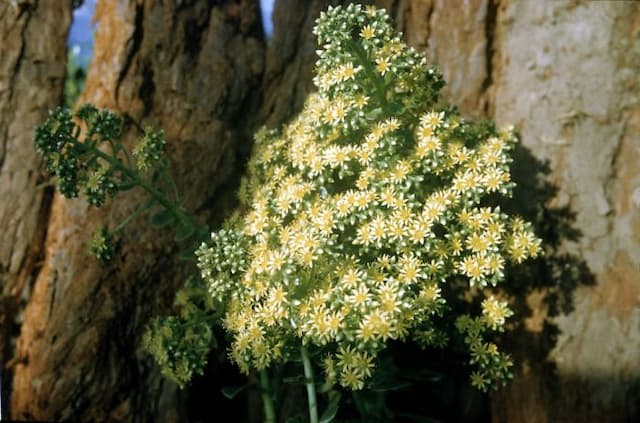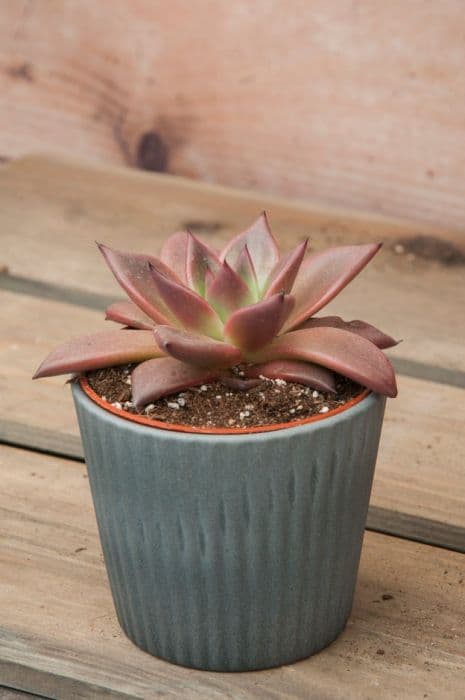Goldmoss Stonecrop Sedum acre

ABOUT
The common name of Sedum acre is Goldmoss Stonecrop. This plant has a bright green, succulent foliage that densely covers its sprawling stems. The leaves are small, needle-like, and packed closely together, giving it a soft, mossy appearance. During the warmer months, it bursts into a profusion of tiny, star-shaped yellow flowers that blanket the plant, adding a vivid splash of color to its surroundings. The Goldmoss Stonecrop is mat-forming, creating a vivid carpet-like ground cover with its fleshy leaves and vibrant flowers. Its resilient and hardy nature is characterized by its ability to withstand relatively tough conditions while maintaining its lush and decorative look.
About this plant
 Names
NamesFamily
Crassulaceae.
Synonyms
Goldmoss, Biting Stonecrop, Wallpepper, Goldmoss Sedum, Mossy Stonecrop, Golden Carpet, Stonecrop.
Common names
Sedum acre, Sedum aldolphii, Sedum dasyphyllum, Sedum elegans, Sedum gredense, Sedum majus, Sedum neglectum, Sedum peisonis, Sedum reflexum, Sedum villosum.
 Toxicity
ToxicityTo humans
Goldmoss stonecrop contains alkaloids and saponins, known to cause poisoning if ingested. Generally, the plant is not deadly, but it can cause discomfort. Symptoms of goldmoss stonecrop poisoning may include vomiting, diarrhea, stomach pain, and skin irritations. It might also cause a burning sensation in the mouth if eaten. Care should be taken not to consume any part of goldmoss stonecrop, as its toxicity can lead to unpleasant but typically not life-threatening symptoms.
To pets
Goldmoss stonecrop can be toxic to pets if ingested. This toxicity is due to the presence of alkaloids and saponins. If pets consume goldmoss stonecrop, they may experience symptoms such as vomiting, diarrhea, drooling, and stomach upset. There is also a risk of skin irritation if they come into contact with the sap of the plant. While the toxicity is generally not fatal, it can cause significant discomfort to pets, and it is advisable to prevent them from ingesting any part of goldmoss stonecrop.
 Characteristics
CharacteristicsLife cycle
Perennials
Foliage type
Evergreen
Color of leaves
Green
Flower color
Yellow
Height
0.1 feet (3 cm)
Spread
1 feet (30 cm)
Plant type
Succulent
Hardiness zones
5
Native area
Europe
Benefits
 General Benefits
General Benefits- Low Maintenance: Sedum acre, commonly known as goldmoss, is easy to care for and does not require frequent watering or fertilizing.
- Drought Tolerant: Goldmoss is highly resilient to drought, making it ideal for arid climates and water-conservative gardens.
- Soil Erosion Control: The dense matting habit of goldmoss helps to prevent soil erosion on slopes and in rocky areas.
- Ground Cover: Goldmoss provides a thick carpet of foliage, covering the ground and suppressing weed growth effectively.
- Attracts Pollinators: The flowers of Sedum acre attract bees, butterflies, and other beneficial insects, promoting biodiversity.
- Easy Propagation: This plant easily propagates from cuttings or division, allowing for simple spread and cultivation in garden spaces.
- Ornamental Appeal: With its bright yellow flowers and lush green foliage, goldmoss adds aesthetic appeal to rock gardens, borders, and paths.
- Tolerance to Poor Soil: Sedum acre can thrive in poor soil conditions where other plants might struggle to survive.
- Rapid Growth: Goldmoss grows quickly, providing fast coverage and a swift response to landscaping needs.
- Versatility: This plant can be used in a variety of garden designs, from formal to wild, due to its adaptability and ornamental qualities.
 Medical Properties
Medical Properties- Diuretic effects: Sedum acre has been traditionally used for its diuretic properties, which help promote urine production and alleviate fluid retention.
- Anthelmintic properties: It has been used in folk medicine as an anthelmintic to expel parasitic worms from the body.
- Astringent: The plant has astringent properties, which can be used to tighten tissues and reduce secretions.
- Vermifuge: It is sometimes used as a vermifuge, an agent that expels worms.
- Anti-inflammatory: Sedum acre may have anti-inflammatory effects, which could help reduce inflammation in various conditions.
 Air-purifying Qualities
Air-purifying QualitiesThis plant is not specifically known for air purifying qualities.
 Other Uses
Other Uses- Sedum acre, commonly known as goldmoss stonecrop, can be used as a water-wise solution in gardens due to its drought-resistant nature, reducing the need for frequent watering.
- In rock gardens or alpine gardens, goldmoss stonecrop can serve as ground cover that helps prevent soil erosion while adding texture and color.
- This plant can be used in green roofing systems due to its low maintenance, shallow rooting, and resistance to extreme weather conditions, contributing to building insulation and habitat creation.
- Goldmoss stonecrop can be planted in cracks of walls or walkways, where it will grow to give a naturalized, aged look to the stonework.
- Owing to its dense mat-like growth, it can be used to outcompete and thus control the growth of weeds in gardens.
- The bright yellow flowers of goldmoss stonecrop can be used to attract pollinators such as bees and butterflies, supporting biodiversity in the garden.
- When used in container gardening, it provides an easy-to-care-for choice that spills attractively over the sides of pots and hanging baskets.
- In model railroading or dioramas, the textured and spreading habit of goldmoss stonecrop can represent shrubs or lawn areas in miniature landscapes.
- Goldmoss stonecrop has been traditionally used as a resilient ground cover along pathways and between stepping stones, where frequent foot traffic is present.
- Creative gardeners may utilize Sedum acre as a living mulch, providing a more aesthetic and living alternative to traditional wood or straw mulches.
Interesting Facts
 Feng Shui
Feng ShuiThe plant Sedum acre, commonly known as goldmoss, is not used in Feng Shui practice.
 Zodiac Sign Compitability
Zodiac Sign CompitabilityThe plant goldmoss is not used in astrology practice.
 Plant Symbolism
Plant Symbolism- Resilience: Sedum acre, commonly known as Goldmoss stonecrop, has the ability to thrive in poor soil and handle drought conditions, making it a symbol of resilience and toughness.
- Tenacity: This plant's propensity to spread and cling to rocky surfaces with its shallow roots showcases its tenacious grip on life, even in challenging circumstances.
- Adaptability: Goldmoss stonecrop can adapt to a wide range of environments, making it emblematic of the ability to adjust and succeed in different conditions.
- Prosperity: With its vibrant yellow flowers, Sedum acre is often associated with prosperity and the bright, positive energy of abundance.
- Endurance: The hardy nature of this plant, which allows it to survive in many settings where other plants would not, symbolizes endurance and longevity.
 Water
WaterGoldmoss stonecrop requires minimal watering and should be watered thoroughly only when the soil is completely dry. Typically, it needs watering once every two weeks during the growing season. Reduce watering to once a month during the dormant winter season. When you do water, use approximately half a gallon for a medium-sized outdoor plant. For potted indoor plants, use just enough water to moisten the soil without causing waterlogging, ranging from a few ounces to about a quarter of a gallon, depending on the size of the container.
 Light
LightGoldmoss stonecrop thrives in conditions with full sun to partial shade. It prefers a location where it can receive at least 6 hours of direct sunlight daily. The bright, direct light promotes healthy growth and enhances the vibrant colors of the foliage. However, in extremely hot climates, some afternoon shade can be beneficial to prevent scorching.
 Temperature
TemperatureGoldmoss stonecrop is hardy and can withstand a wide range of temperatures, but ideal growing conditions are between 65°F and 75°F. It can survive minimum temperatures down to around 30°F and can tolerate heat above 90°F as long as proper care is provided. The plant is hardy in USDA zones 4 through 9, making it versatile for various climates as long as it's not exposed to prolonged extreme cold.
 Pruning
PruningPruning Goldmoss stonecrop is usually done to maintain the plant's shape, remove dead or damaged foliage, and encourage bushier growth. It's best to prune in early spring before new growth begins. Pruning can be done again after flowering to promote a second bloom and keep the plant compact. Remove spent flower stems and trim back the foliage lightly as needed.
 Cleaning
CleaningAs needed
 Soil
SoilGoldmoss Stonecrop thrives best in a well-draining soil mix with a pH of 5.5 to 7.0. A mix of regular potting soil, coarse sand, and perlite or pumice in equal parts is ideal to facilitate good drainage and prevent root rot. Regular garden soil should be avoided as it can retain too much moisture and cause the plant to suffer.
 Repotting
RepottingGoldmoss Stonecrop is a low-maintenance plant that does not need frequent repotting. It can be repotted every 2-3 years or when it outgrows its current container. Ensure that the new pot has adequate drainage holes and use a fresh soil mix to replenish nutrients.
 Humidity & Misting
Humidity & MistingGoldmoss Stonecrop is adapted to withstand dry conditions and prefers low humidity environments. It does not require any special humidity considerations and will do well in the average room humidity found in most homes.
 Suitable locations
Suitable locationsIndoor
Place Goldmoss Stonecrop in bright sunlight.
Outdoor
Plant Goldmoss Stonecrop in full sun to partial shade.
Hardiness zone
3-9 USDA
 Life cycle
Life cycleSedum acre, commonly known as Goldmoss Stonecrop, begins its life cycle as seeds, which germinate in spring when conditions are favorable—warm temperatures and moist soil. The seedlings develop into juvenile plants, establishing a root system and a rosette of leaves close to the ground. As the plant matures, it enters the vegetative stage, growing rapidly and spreading through rhizomes or stolons, forming a dense mat of succulent foliage. Goldmoss Stonecrop flowers in the summer, producing small, star-shaped yellow flowers that attract pollinators, leading to the reproductive stage. After pollination, seeds form and are dispersed by wind, water, or animal activity. The plant goes dormant in winter, reducing above-ground growth and conserving energy in its root system until the cycle begins anew in spring.
 Propogation
PropogationPropogation time
Spring-Early Summer
The most popular method of propagation for Sedum acre, commonly known as Goldmoss Stonecrop, is through division. This technique involves separating the plant into smaller sections during the active growing season, typically in spring or early summer. Gardeners gently loosen the soil around the plant and carefully lift it out of the ground, making sure to maintain a good amount of roots attached to each section. Divisions can be replanted immediately in well-draining soil, spaced about 6 to 12 inches (approximately 15 to 30 centimeters) apart to give them room to grow. The newly planted sections should be watered thoroughly to establish them in their new location, after which they will quickly take root and continue to spread.









